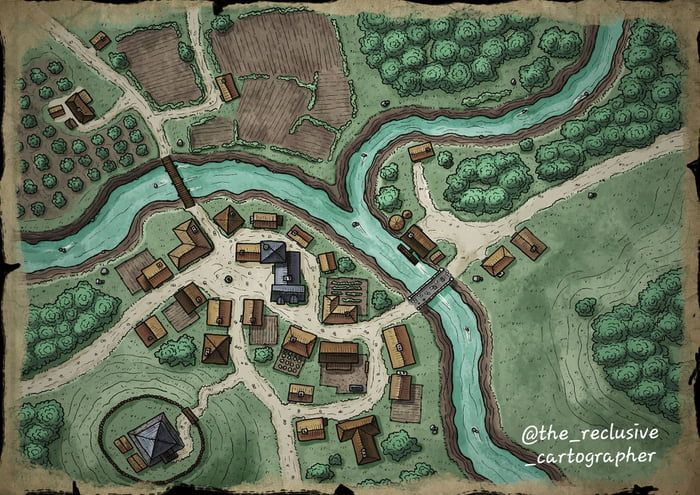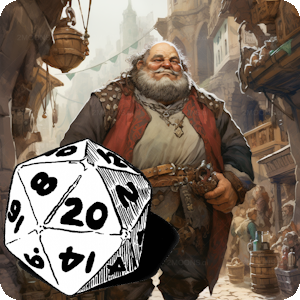In Dungeons & Dragons (D&D), the setting is as much a part of the story as the characters or the dungeon itself. A city or village can become a vibrant backdrop for your campaign, providing endless opportunities for storytelling, intrigue, and adventure. Whether you are designing a sprawling metropolis or a humble village, the key is to make the setting dynamic, engaging, and full of adventure hooks. Here’s how you can create a story around a city or village map for your next D&D adventure.

1. Establish the Tone and Purpose of the City/Village
Before diving into the map, it’s important to decide on the overarching tone and purpose of the settlement. This will inform the types of locations, NPCs (non-player characters), and quests that the players will encounter. Think about the following:
- Is the city thriving or decaying? A bustling metropolis will have different challenges and intrigue compared to a town struggling with poverty or political corruption.
- What role does the settlement play in the larger world? Is it a hub for trade, a stronghold against evil, a place of religious significance, or a center of arcane study?
- What factions or power struggles exist? Consider any guilds, political factions, cults, or criminal organizations operating within the settlement. These can serve as antagonists or allies for your players.

2. Map Out Key Locations and Districts
The map is the skeleton of your story. As you draw or select a map, ensure that it highlights the critical locations that can drive your adventure. Here are some key parts of a city or village that will shape the story:
1. Town Square / Central Hub
- Purpose: This is where your players will likely start or return frequently. It could serve as the location for initial quests, key NPCs, or major events.
- Potential Plot Hooks: Public announcements, festivals, or a place where characters can meet their contacts or allies. There might also be a hidden threat lurking in plain sight.
2. Government Building or Lord’s Manor
- Purpose: The center of power in the settlement, where local leaders or rulers live and work.
- Potential Plot Hooks: Political intrigue, assassination attempts, or royal decrees. It could also serve as a source of quests, such as defending the realm or investigating a threat to the leadership.
3. Marketplace / Bazaar
- Purpose: A lively space for trade, commerce, and interactions. It offers a rich environment for encounters with merchants, shady figures, and locals.
- Potential Plot Hooks: The marketplace can be the site of a theft, a black market deal, or a protest against high taxes. Players could also learn rumors or gather supplies.
4. Tavern / Inn
- Purpose: The social gathering spot where adventurers meet other travelers and locals. Taverns are iconic in D&D for quests and rumors.
- Potential Plot Hooks: The innkeeper may have an interesting job for the players, or a mysterious stranger may hire them for a job. A tavern brawl or a lost patron’s tale could lead to a larger adventure.

5. Religious or Temple District
- Purpose: The spiritual heart of the settlement, where citizens seek guidance, healing, and divine intervention.
- Potential Plot Hooks: A temple may become a source of conflict if an ancient artifact is stolen, or if the local clerics are dealing with a divine curse. Religious cults could add an element of mystery or danger.
6. Guilds and Crafting Districts
- Purpose: Locations where various guilds—mages, thieves, blacksmiths, and more—operate. These can be places for economic and magical power in the city.
- Potential Plot Hooks: Guild rivalries, secretive magical experiments, or black-market dealings. Guild members may need adventurers to solve problems that threaten their influence.
7. Slums or Shady Districts
- Purpose: The underbelly of the settlement, often home to the poor, criminals, and other outcasts. This part of the city can provide a contrast to more prosperous areas.
- Potential Plot Hooks: Secret meetings of criminals, hidden treasure caches, or a quest to investigate the disappearance of a local figure. This area could also be rife with dark magic or dangerous creatures lurking in the shadows.
8. Barracks / Military Outpost
- Purpose: If the city has a standing army or militia, the barracks is a place of order and discipline. Here, players can encounter soldiers, mercenaries, and commanders.
- Potential Plot Hooks: A possible military coup, a threat from an outside force, or recruitment for a dangerous mission. Players may need to resolve a conflict between soldiers and civilians or assist in defending the city.
9. Sewers and Underground Tunnels
- Purpose: Often overlooked, the sewers and tunnels can hold dark secrets, forgotten enemies, or treasure.
- Potential Plot Hooks: Players may be hired to clean out monsters, investigate a missing person, or discover a hidden lair beneath the city. This area can also be a hideout for criminals or a source of contamination.
3. Introduce Conflict or Mysteries
Every good city or village needs tension to drive the story. Conflict can come from both external and internal sources, and your map should hint at these sources. Here are some examples of conflicts or mysteries to weave into your story:
- Political Struggles: The ruling class is divided, and factions are vying for control. The players could find themselves involved in espionage, sabotage, or a full-fledged rebellion.
- Supernatural Threats: A curse is spreading, strange creatures are seen in the streets at night, or a magical disaster is imminent. Perhaps the city’s history holds dark secrets that are now resurfacing.
- Economic Problems: The city is on the brink of collapse due to famine, plague, or a lack of resources. A wealthy merchant guild might be hoarding supplies or an influential noble might be involved in illegal trade.
- External Attacks: The city could be under siege by bandits, monstrous creatures, or a rival kingdom. The players might need to help defend the city or investigate the source of the threat.
4. Develop NPCs to Populate the City/Village
A city or village thrives through its inhabitants. Think of who lives and works in these key locations, and how they interact with one another. Some key NPCs might include:
- The Mayor or Ruler: Perhaps a benevolent or tyrannical figure who has a vested interest in what happens to the players.
- The Guildmaster or Innkeeper: Someone who knows the pulse of the city and can offer the players side quests.
- A Mysterious Stranger: A NPC who can act as a catalyst for adventure or provide cryptic information.
- The Villain: Every city needs a villain, whether it’s a criminal mastermind, corrupt politician, or dark wizard pulling strings behind the scenes.

5. Create a Sense of History and Depth
A settlement feels more alive when it has a rich history. Whether the city is ancient or recently founded, think about its past. Maybe a long-forgotten war left scars on the land, or an ancient dragon once ruled the city. The history can affect the present, creating opportunities for your players to uncover lost secrets or help rebuild.
Now you are ready to go into an adventure!
A city or village in Dungeons & Dragons isn’t just a static map; it’s a vibrant, dynamic part of your campaign that can shape the direction of your story. By focusing on key locations, NPCs, conflicts, and mysteries, you can create a setting that feels alive and full of adventure. Whether it’s a place of high drama or hidden dangers, the settlement will become a central character in its own right—one that your players will remember long after the adventure is over.
